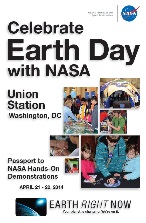- Home
- Missions
- Data
- Communications
- People
- The Earth Observer Newsletter
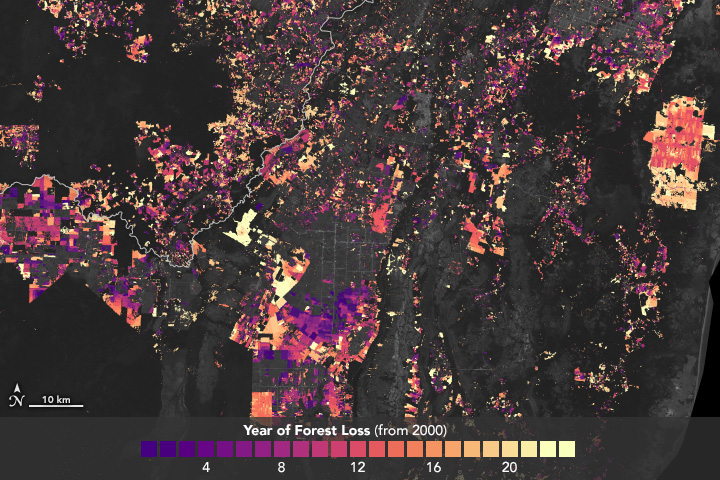
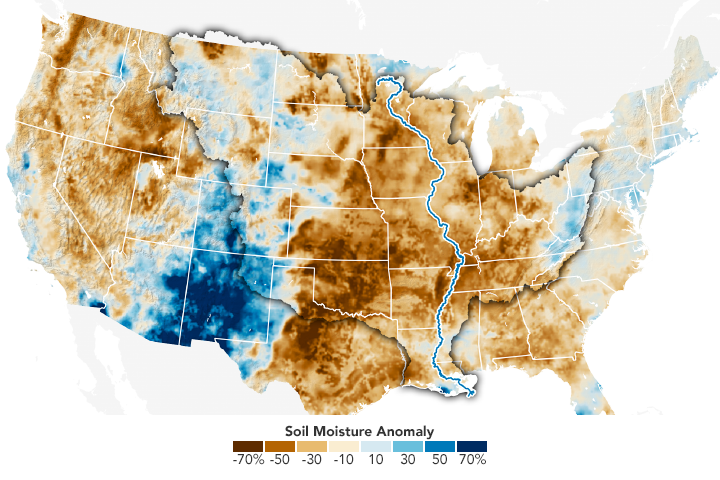


Recent Imagery
You will be directed to the NASA Visible Earth webpage when you select Images by Mission below, or click on the images at right that are randomly generated to represent four out of all possible topics.
Celebrate Earth Day with NASA!
Celebrate Earth Day with NASA!
Submitted by Heather Hanson on Wed, 2014-03-19 14:57
Earth Right Now
Your planet is changing, We're on it.
Like all things in life, Earth’s environment is in a constant state of flux. Components of the Earth system—including the atmosphere, hydrosphere, lithosphere, cryosphere, and biosphere—are all connected, and interact in complex ways that we do not fully understand. At NASA, our goal is to study the Earth as a system and understand how both natural and human-induced changes impact Earth’s environment over time.
To find out how our planet is changing and what NASA is doing to better understand and predict these changes, come celebrate Earth Day with NASA at Union Station in Washington, DC, April 21-22, 2014. NASA’s Hyperwall and Science Gallery exhibits will be on display, and a variety of hands-on demonstrations and activities will be located in the Main Hall. On Tuesday, April 22 (official Earth Day), nearly 20 NASA scientists will reveal the “big picture” to help tell fascinating science stories about our changing planet.
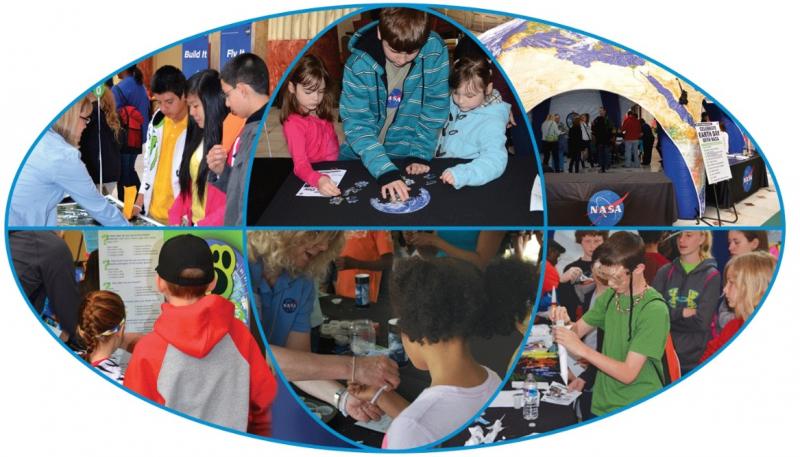
Live Hyperwall Presentation Schedule
Tuesday, April 22 (Earth Day)
Storytelling like never before! NASA’s Hyperwall displays large visuals that provide new perspectives of Earth’s environment, the sun, our solar system, and the universe.
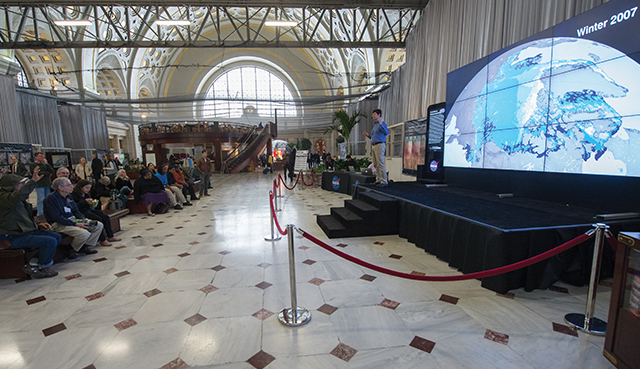
11:00 – 11:15 AM
Opening Remarks—Kathryn Roger, President of Earth Day Network; Dr. John Grunsfeld, Associate Administrator of the Science Mission Directorate, NASA Headquarters; Mark Polhemus, Genearl Manager of Union Statoin; Dr. Michael Freilich, Director of the Earth Science Division, NASA Headquarters; Gwen Camp, Director of Individual and Community Preparedness at FEMA
11:15 – 11:25 AM
NASA’s View of Earth from Space—Dr. Jack Kaye, Associate Director for Research of the Earth Science Division, NASA Headquarters
11:30 – 11:40 AM
Believe It or Not, Spring is Coming Earlier!—Dr. Compton Tucker, NASA’s Goddard Space Flight Center
11:45 – 11:55 AM
Changes in the Antarctic Peninsula—Dr. Chris Shuman, NASA’s Goddard Space Flight Center
12:00 – 12:10 PM
Measuring Rain and Snow for Science and Society—Dr. Dalia Kirschbaum, NASA’s Goddard Space Flight Center
12:15 – 12:25 PM
Our Planet is Changing: Perspective from Space—Dr. Michelle Thaller, NASA’s Goddard Space Flight Center
12:30 – 12:35 PM
2014: A Big Year for Earth at NASA—NASA Administrator Charles Bolden, NASA Headquarters
12:40 – 12:50 PM
Continuing the 40-Year Legacy with Landsat 8—Dr. James Irons, NASA’s Goddard Space Flight Center
12:55 – 1:05 PM
Protecting Earth from Solar Storms—Dr. Lika Guhathakurta, NASA Headquarters
1:10 – 1:20 PM
Observing Earth’s Poles—Dr. Thomas Wagner, NASA Headquarters
1:25 – 1:35 PM
Measuring Air Pollution from 440 Miles Above the Earth’s Surface—Dr. Edward Celarier, NASA’s Goddard Space Flight Center
1:40 – 1:50 PM
Eyes on the Earth 3D: Come Fly With NASA—Kevin Hussey, NASA/Jet Propulsion Laboratory
1:55 – 2:05 PM
The Universe in Earth Day—Dr. Rachel Osten, Space Telescope Science Institute
2:10 – 2:20 PM
Earth’s Biodiversity: The View from Space—Dr. Allison Leidner, NASA Headquarters
2:25 – 2:35 PM
Hubble and Spitzer’s Frontier Fields—Dr. Dan Coe, Space Telescope Science Institute
2:40 – 2:50 PM
Journey to Mars—Dr. Michelle Thaller, NASA’s Goddard Space Flight Center
2:55 – 3:05 PM
NASA’s Search for Other Earth-Like Worlds—Dr. Debra Wallace, NASA Headquarters
3:10 – 3:20 PM
Looking Homeward—Dr. Ellen Stofan, NASA Chief Scientist, NASA Headquarters
3:25 – 3:35 PM
America's PrepareAthon!—Gwen Camp, Director of Individual and Community Preparedness at FEMA
3:40 – 3:45 PM
Weather Ready and Climate Smart Nation—TBD, National Oceanic and Atmospheric Administration
NASA’s Science Gallery
April 21-22
The Science Gallery exhibit reveals 12 fascinating science stories about our changing planet.
Hands-On Demonstrations
April 21-22
Dynamic Planet
This touchscreen interface allows users to drive a spherical display that shows a variety of remote sensing satellite datasets.
Eyes on the Earth 3D: Come Fly with NASA!
Eyes on the Earth is a three dimensional (3D) visualization experience that lets users “fly along” with NASA’s fleet of Earth science missions and observe climate data from a global perspective in an immersive, real-time environment.
*What on Earth?
Look closely at these Earth photos to determine just “What on Earth” it is. Get clues from the Earth Science Picture of the Day (EPOD).
Space Racers
Space Racers is a new animated television program following young Space Rocket cadets as they soar through the solar system learning about scientific investigation and observation, space exploration, and the importance of working together as a team. Visit the Space Racers Kiosk for an exclusive sneak peak of our new “Space Collector” game, plus prizes and giveaways.
Science Casts
Science Casts are short videos about fun, interesting, and unusual science topics encountered by NASA’s science missions. Catch a new episode every week as we look into the science behind discoveries on Earth, in the solar system, and beyond…Learn more at sciencecasts.nasa.gov
iSat
Interactive Satellite Tracker (iSat) is a browser-based application that allows you to track all NASA Science Satellite Missions, as well as other satellites.
Calculate Your Carbon Footprint
Calculate your carbon footprint and discover where you fall on the “Green-o-Rometer.” We’ll even offer simple tips on ways to reduce your carbon consumption.
UV Detecting Beads
NASA keeps a close eye on the sun’s ultraviolet (UV) radiation and you can too! Become a UV detective with specially designed UV sensitive beads and walk away with your very own UV detection bracelet.
Learning Remote Sensing with Puzzles
Help NASA piece together images taken of Earth from space, including the popular Earth at night image.
Know Your Earth
How well do you Know Your Earth? Here, you can take a quiz and earn a prize if you correctly answer each question. Quizzes can be taken at the Know Your Earth table or on your smart device via a QR code. Through these quizzes, you can learn all about NASA Earth Science
Digital Photo Booth
Get your face in space! You’ll walk away with a real keepsake.
Earth Connection via Suborbital Platforms
Navigate your way though NASA Science and explore various research platforms using two touchscreen kiosks. Touch and feel the materials used to make NASA’s scientific balloons and inflate a cylinder made of the balloon film to observe how the material behaves while the cylinder expands.
Are You a Super Sleuth? Take the Earth Imagery Challenge!
NASA satellites are taking measurements of planet Earth from space. Follow our “clues” to solve the imagery mystery!
Sensors, Circuits, and Satellites
Assemble an energy-sensing circuit and discover how NASA’s Aura satellite can study the chemistry of our atmosphere.
*Cloud in a Bottle: GLOBE Program
Learn about clouds and make a cloud in a bottle. Then, play our Cloud Cover Estimation game.
Puzzling Changes in the Land
Arrange a time series of Landsat images or piece together a Landsat scene to reveal Earth’s changing landscape.
Aviation and the Environment
The Earth’s atmosphere protects life in many different ways. But, what would happen to us if our atmosphere suddenly disappeared? Learn how pilots and astronauts protect themselves as they travel to the very edge of Earth’s atmosphere.
Measuring Precipitation: On the Ground and From Space
Learn how rain gauges work, how the technology of the GPM satellite measures precipitation from space, and why it’s important to look at precipitation patterns around the globe.
*Demonstration on Tuesday, April 22 only.


